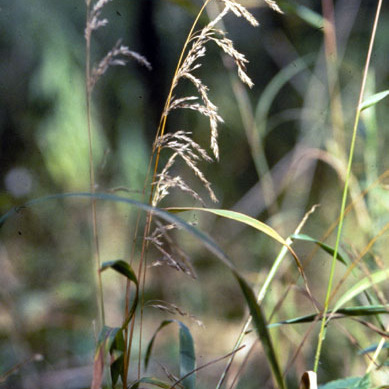Erect perennial; culms slender to rather coarse, 80 cm. to more than 2 m. high; sheaths glabrous, shorter than the internodes; ligule 5-15 mm. long, thin, lacerate; blades 10-30 cm. long, 5-10 mm. wide, flat, acuminate, glabrous or scaberulous, the margins finely scabrous; panicles 15-40 cm. long, the slender drooping branches in distant verticils, naked in the lower half, some of them often as much as 15 cm. long; spikelets somewhat densely clustered, short-pedicellate, 2.5-2.8 mm. long; glumes usually very scabrous; awn of lemma obscure; rudiment slender, glabrous.
Spikelets 1-fld, articulated below the glumes; glumes nearly equal, herbaceous or scarious-margined, linear to narrowly lanceolate, acute or acuminate, 1–3-veined; lemma herbaceous, about equaling the second glume, 3-veined, bearing a short straight awn just below the tip, distinctly stipitate above the glumes; palea 1-keeled; rachilla prolonged as a minute bristle behind the palea; anthers 2 or (our spp.) 1; tall perennials with wide, flat lvs, elongate, membranous ligule, and ample panicles of small spikelets. 5, N. and S. Amer., temp. Eurasia.
Spikelets 1-flowered, disarticulating below the glumes, falling entire; glumes equal, 1-nerved, about as long as the floret; rachilla forming a stipe below the floret, produced beyond the palea as a minute bristle; lemma similar to the glumes, 3-nerved, bearing a minute awn just below the apex; palea a little shorter than the lemma, apparently 1-keeled.

